Expert's Rating
Pros
- Very easy to set up
- An integrated Wi-Fi 6 router renders it a fantastic value
- Good Wi-Fi performance, and its range can be expanded with Eero mesh nodes
- Expandable battery and broadband backup features
Cons
- Disappointingly underwhelming as a smart home hub
- Subscription required for local video processing and storage
- Zigbee radio is still dormant, and there’s no Thread radio
- Poor integration with other smart home devices
Our Verdict
The Ring Alarm Pro is a great home security system that now includes an integrated Wi-Fi 6 router. It could also be a kick-ass smart home hub if Ring just would take a couple of extra steps.
Price When Reviewed
This value will show the geolocated pricing text for product undefined
Best Pricing Today
Best Prices Today: Ring Alarm Pro (8-piece kit)
Ring is one of the most recognized names in the world of DIY home security. We named its second-generation Ring Alarm the best DIY home security system in 2020, and the Ring Alarm Pro will likely earn that distinction this year—even though Ring continues to kick the can down the road when it comes to building a complete smart home hub.
The Ring Alarm Pro’s featured attraction is an integrated Eero 6 router in addition to the Z-Wave, LTE, Bluetooth LE, and (still dormant) Zigbee radios included in the first two generations. There’s also a 900MHz radio to support Amazon’s Sidewalk network. Given the presence of Eero 6 hardware, you’d think there would be a Thread radio onboard, too, but there isn’t. You can incorporate Thread into the system by adding one or more Eero mesh nodes.
This review is part of TechHive’s coverage of the best smart home systems, where you’ll find reviews of the competition’s offerings, plus a buyer’s guide to the features you should consider when shopping for this type of product.
Existing Ring Alarm users can upgrade just the hub for $250, but that’s only $50 less than the entire eight-piece kit reviewed here. You’d be better off buying the kit and deploying the motion sensor, four door/window sensors, keypad, and range extender around the house. In addition to the kit, Ring also sent a Ring Stick Up Cam Battery, a Ring Power Pack backup battery, and an additional Eero 6 node.
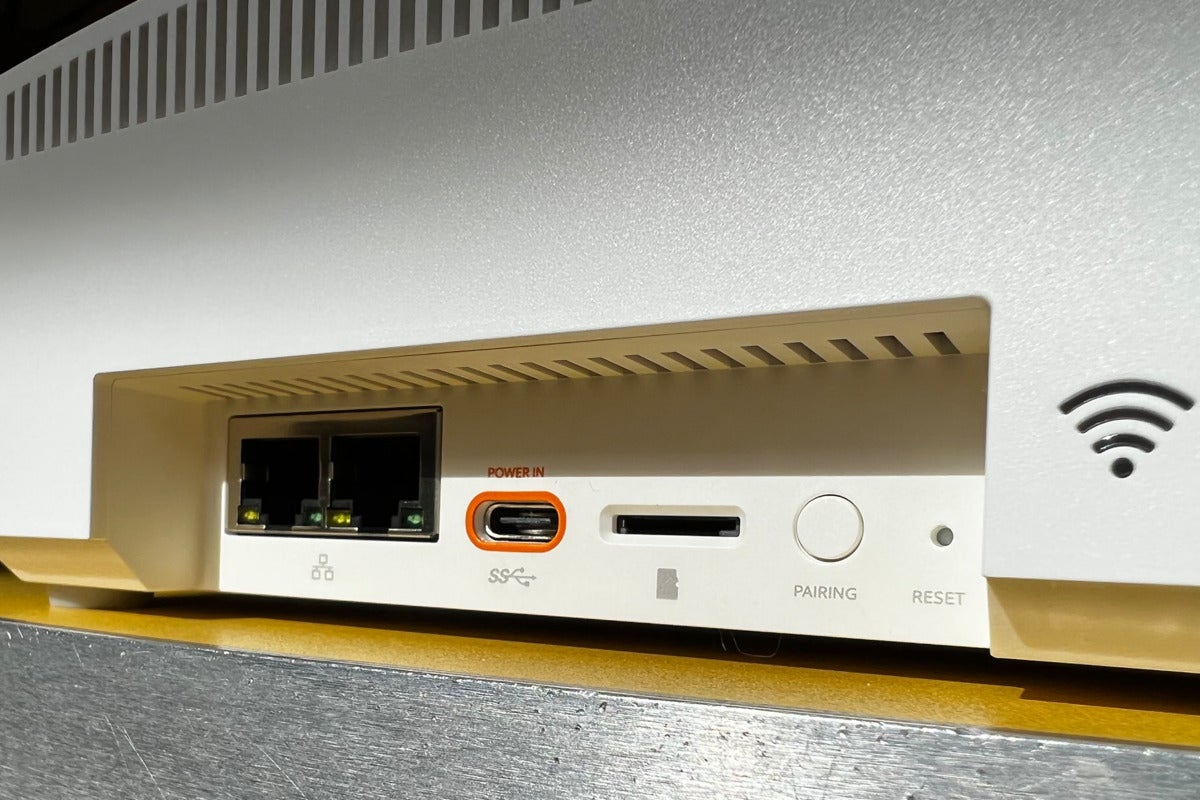 Wes Davis / IDG
Wes Davis / IDG
Ports on the Ring Alarm Pro (left to right): Two auto-sensing gigabit ethernet ports (one for WAN, one for LAN), a USB-C port for power, and a microSD card slot for storing video from Ring cameras.
If you’re new to Ring Alarm and don’t need—or just don’t want—a new mesh Wi-Fi router with your alarm system, you might consider buying the second-generation Ring Alarm instead. Here again, however, the Ring Alarm Pro costs only $50 more and it includes a lot of extra features. Prima facie, embedding a router in the Ring Alarm Pro feels like a step towards that great unified smart home system Ring has long promised to deliver, but it’s not there yet, for reasons I’ll cover below.
Thanks largely to the router integration, the Ring Alarm Pro has gained a pair of gigabit ethernet ports in back. A USB-C power port replaces the barrel connector on the earlier models, and there’s a new and welcome feature: a microSD card slot that lets you store video footage from your Ring video doorbell and security cameras (more on that later). Ring has moved the pairing and reset buttons, but it retained the LEDs to indicate wireless connectivity and power. Mounting holes give you the option to hang the hub on the wall.
Timing constraints meant I wasn’t able to dedicate the same amount of time that TechHive’s Michael Brown put into his in-depth analysis of the Ring Alarm (2nd Gen). I’ll touch on every part of the new system here, but I’ll focus primarily on the updates. I’ll also discuss my experience with the accessories that come with the kit I was sent.
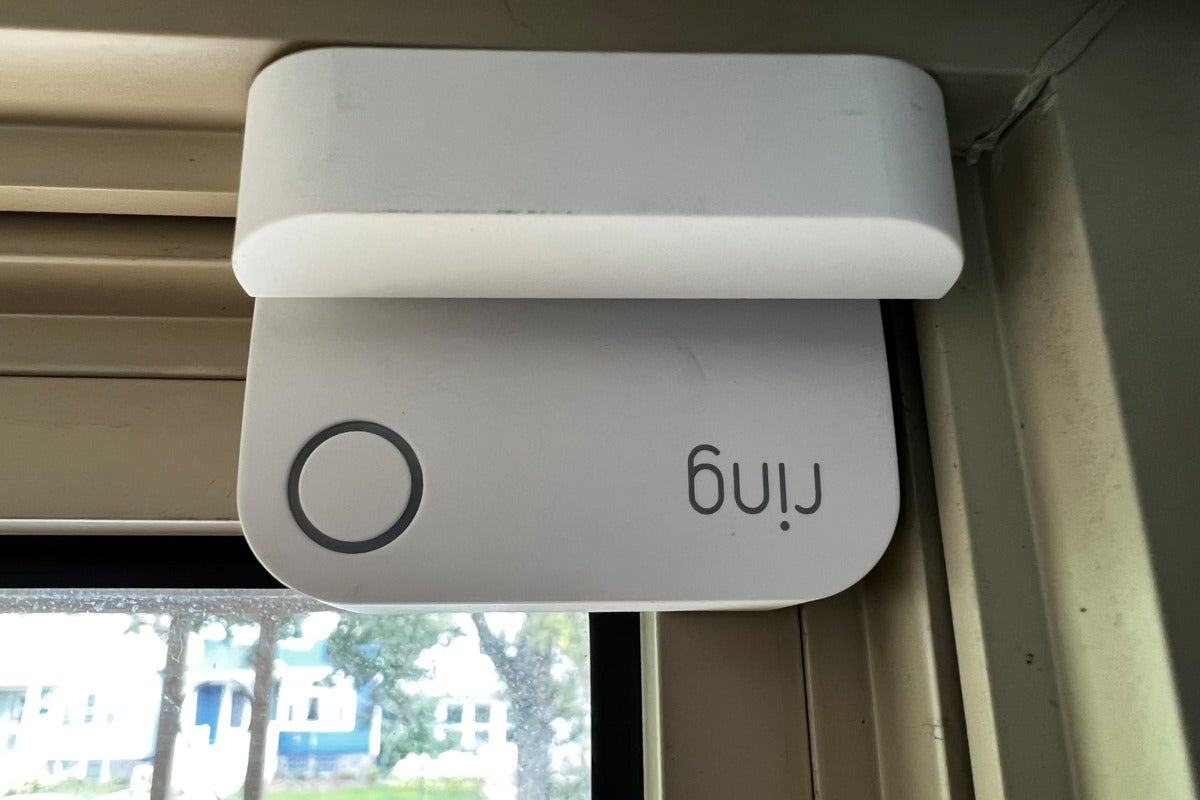 Wes Davis / IDG
Wes Davis / IDG
The same contact sensors are used for doors and windows, and they can’t be hidden.
Foolproof installation
Setting up the Ring Alarm Pro is remarkably frustration free. The process took me about a leisurely hour all told, and that was only because I was stopping to take pictures and screenshots and wasn’t in a hurry. Pairing the accessories was straightforward, and the Ring app walked me through the process as gently as you please, stopping me at every step to check each device to ensure it functioned as intended. Tapping on each device in the app brings up a clear and concise installation video to help with installation. To pair each device, you simply pull out a plastic tab at the battery compartment, so the device can power up. Once that’s done, the device immediately looks for a connection to the hub. After that, it’s just a matter of placing the accessory in its desired location. For the included motion and contact sensors, this was a matter of cleaning the surface I wanted to place them on, then peeling the film off the adhesive backing and sticking them to the walls, doors, and windows I wanted to monitor.
Sensor installation and performance
The magnetic door/window sensors can tolerate a gap of about one inch between the two pieces. If your doors and windows are misaligned or so deeply recessed that there’s more than one inch of space between the two pieces, you could get false readings indicating they’re open when they’re not. In my house, they worked perfectly on every door I stuck them on, including my deeply recessed back door, which gives my Ecobee door/window sensor quite a bit of trouble. I configured each sensor to notify me when they opened, and there was almost no delay between the moment a sensor was tripped and when I got the notification on my phone. That’s not always the case with the Ecobee sensors I use.
Each sensor can be configured as a main door, a secondary door, or a window. Main doors will provide an entry delay that gives you time to enter the house and disarm the system and the keypad before the alarm goes off. Windows, along with secondary doors, will set the alarm off immediately if they’re opened while the system is armed.
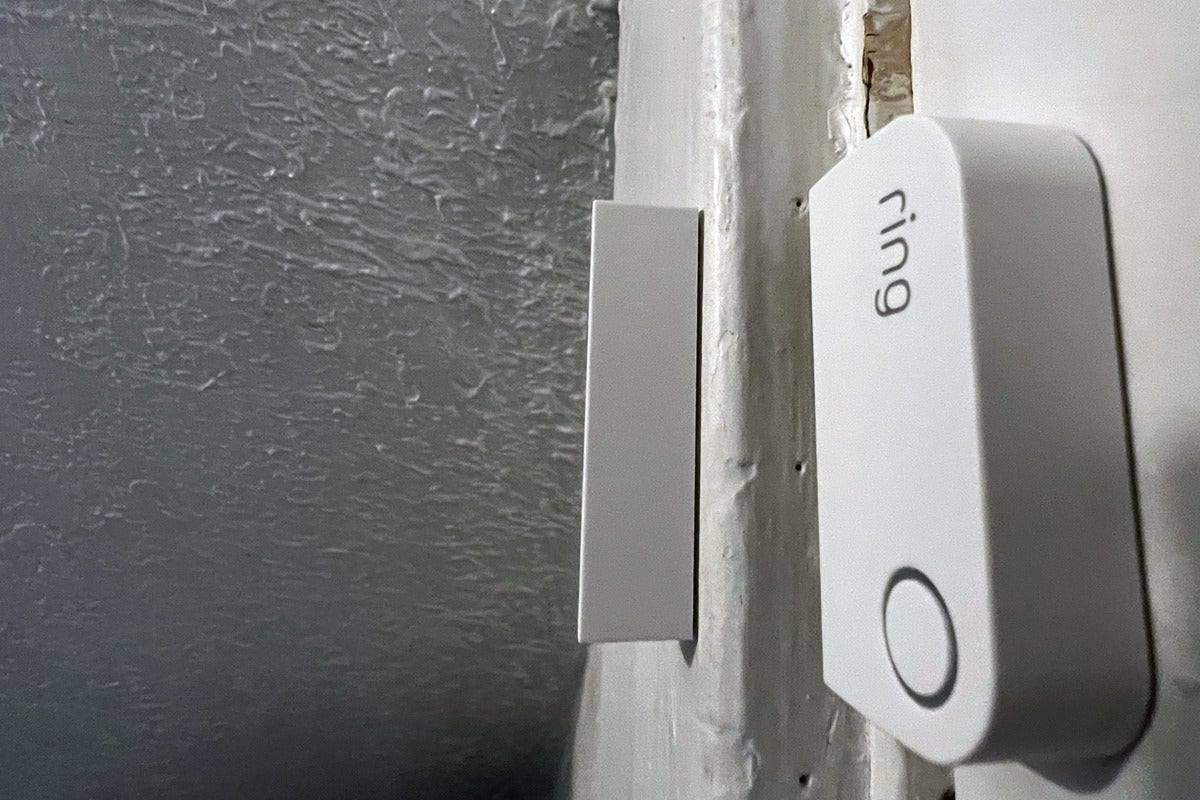 Wes Davis / IDG
Wes Davis / IDG
Ring’s contact sensors proved very tolerant of installation in less-than-ideal locations. This one correctly reported the door as being closed despite the yawning gap between the two components.
The motion sensor was similarly easy to install and use, with the added clever option of adhesive pads that allow for mounting in either a corner or on a flat wall. The motion sensor reported motion accurately, even in the somewhat challenging, tight space I put it in, and I was unable to sneak past it, even by crouching and hugging the wall. I set it to the middle of its three sensitivity settings, which Ring says is best for homes with small pets. My cat and my small dog were able to move around the house freely without setting the system off.
The mobile keypad is the only part of the installation that required any sort of tools, and that’s only if you want to mount its holster to the wall. The holster has three screw holes, and Ring provides the screws and drywall anchors you’ll need. The keypad slides into the holster. The keypad is powered by a rechargeable battery, and it comes with power cable that fits snugly into a cavity in the back of the unit. The keypad is outfitted with big, easy-to-read buttons, including dedicated buttons for summoning fire, police, or emergency medical services, but you must be a Ring Protect subscriber for that feature to work (much more on that later). An onboard proximity sensor fires up a backlight as you approach, so you can see the buttons in the dark.
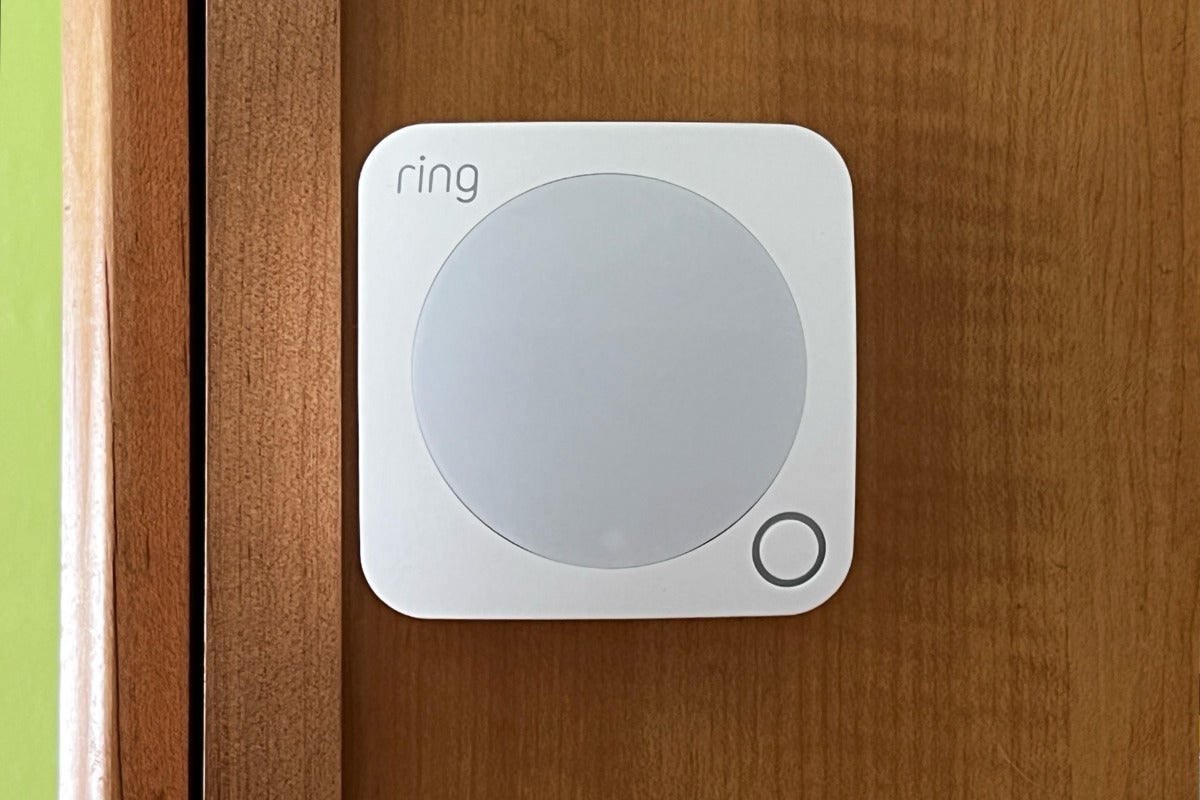 Wes Davis / IDG
Wes Davis / IDG
Ring’s motion sensor can be mounted on either a flat surface or in a corner.
Bells and whistles, sirens and beeps
The Ring Alarm Pro is a noisy system by default, wanting to notify you with a beep every time a door or window sensor is tripped. The default volume is a bit high, and my spouse was quick to ask me if it was going to make that noise every time something happened. I poked through the options and found one to turn off what Ring calls Chirp Tones, but not before I went through all the other volume-level options in search of one I could live with (there wasn’t one). Still, I wanted to be alerted of any sensor being tripped, so I brought an Amazon Echo Flex out of mothballs and set it up in the same room as the Alarm Pro. I then configured the smart speaker with a series of Alexa routines that would announce—quietly—when any door opened.
Later, while testing the alarm itself, I found its 104dB siren (same as the previous generation) loud enough to be a little startling—at least when I was inside the house. When I walked just a few feet into my yard, it was barely audible with the door was closed. Ring warns that your neighbors will hear the siren firing off, but I think they’d need to have very good hearing. Ring had an outdoor siren at one time, but it is currently not available in North America (you can buy one in the U.K., though).
Ring Alarm Pro router performance
The specs of the Ring Alarm Pro’s integrated router match those of the stand-alone Eero 6: It’s rated to cover a 1,500-square-foot home, and it can deliver up to 900Mbps over ethernet when used on its own. Being an Eero router, you can expand your network’s reach with additional mesh nodes. This will impact throughput, because those nodes consume some bandwidth talking to each other, but expanding a mesh network also can fix dead spots and improve the stability and responsiveness of your Wi-Fi-based smart home devices.
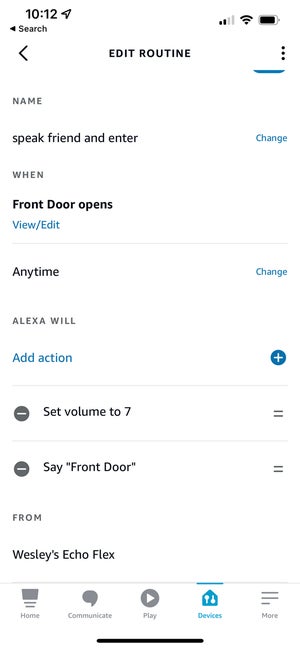 Wes Davis / IDG
Wes Davis / IDG
The best way to create home automation scenes with the Ring Alarm Pro is to create Alexa Routines, but that depends on a completely different app and user interface.
Setup of the router portion of the Ring Alarm Pro can be accomplished either via the Ring app (which whisks you away to the Eero app when the time comes), or by cutting out the middleman and going straight to the Eero app. You can do this before or after you set up the Alarm Pro itself.
One of our primary criticisms of the Ring Alarm (2nd Gen) was that you must create Alexa Routines if you want Ring motion and contact sensors to trigger Z-Wave-powered lights and other smart home accessories—even the ones that Ring certifies as compatible via its Works with Ring program. That is still the case with the Ring Alarm Pro; in fact, you must use the Ring app to turn off one of the LEDs on top of the hub, and then open the Eero app to turn off the other one. This bifurcation of function does Ring no favors, as it makes the Eero router feel tacked on as an afterthought instead of a well-integrated component.
As an avid Eero user, it’s also annoying to see existing features—including Apple HomeKit compatibility and Zigbee smart-home hub capabilities—chopped out. Not much else has changed with the Works with Ring program, apart from the addition of two Honeywell Home smart thermostats.
Smart home kvetching aside, the Eero 6 router inside the Ring Alarm Pro performs exactly as you’d expect a stand-alone Eero 6 router would. To benchmark it, I used a 2019 Lenovo Yoga equipped with an Intel AX201 Wi-Fi 6 NIC to transfer data to my “server,” a 2020 M1 MacBook Air connected to one of the gigabit LAN ports on the back of the Alarm Pro. I performed several iPerf 3 TCP transfer tests at six locations in and around my home, ranging from the easy-to-reach places to more difficult spots, and averaged these tests for the final number. The router exhibited middling-to-good Wi-Fi 6 numbers, averaging 637.2Mbps when the laptop was four feet away and in direct line of sight, and dropping to 591.7Mbps when switched to Wi-Fi 5.
I had similar experiences throughout my house, with the Ring Alarm Pro beating my old Eero Pro everywhere except my basement, where the Pro’s slightly greater range—it’s rated to cover 1,750 square feet—beat it by slightly less than 50Mbps. In my backyard, a location that most Wi-Fi routers struggle to reach—particularly on the 2.4GHz band—the connection was likewise unstable. I could connect to the router’s 5GHz network, but throughput was very low. For a mid-sized home (mine is about 2,000 square feet across three floors, including the basement), you’ll want to add one or two mesh nodes, especially if you’re operating outdoor security cameras. Adding the additional Eero 6 node that Ring provided, plus the Eero Pro nodes I already had, was an easy task, and my network of Wi-Fi and IoT devices became stable, fast, and very responsive afterward.
What else is new?
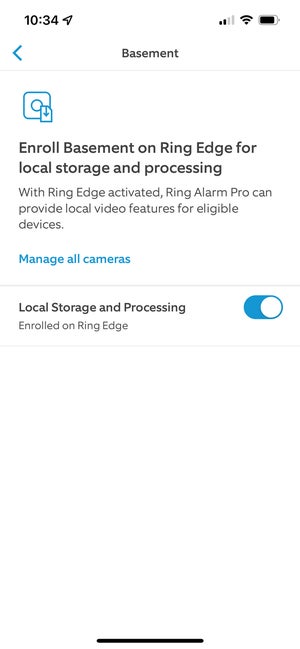 Wes Davis / IDG
Wes Davis / IDG
Ring Edge is one of the Ring Alarm Pro’s best features, but you’ll need a Ring Protect Pro subscription to use it.
In addition to router functionality, the Ring Alarm Pro’s Ring Edge feature delivers local processing and storage of Ring security camera video. This is accomplished via a microSD card with code maximum capacity of 512GB. Ring provides Ring Alarm Pro buyers with a code redeemable for a free microSD card. If you’d prefer to buy a different one, Ring has confirmed a handful of Samsung and SanDisk cards as being compatible.
If you’re thinking local storage frees you from the requirement to pay for a Ring Protect Plan, think again. You can’t use that local storage unless you sign up for Ring Protect Pro, which also includes professional monitoring of your Ring Alarm system, among other things. So, most Ring Alarm Pro buyers will sign up for the service anyway, but this is a particularly egregious example of a company making you pay to unlock a feature that’s built into its product.
You should also know that not every Ring camera is compatible with Ring Edge, and those that are require a firmware update. Finally, you’ll need to disable each Ring camera’s end-to-end encryption feature to use local storage.
Ring Alarm systems have always had LTE backup in case your broadband connection goes down, but only a relatively small battery to keep the system active if you lose power. That changes with the Ring Power Pack, a battery pack with the same 6.63 x 6.63-inch footprint as the Ring Alarm Pro and that fits underneath it. Each pack enables the system to run on battery power for up to eight hours, and you can stack and interconnect up to four Ring Power Packs to get an additional 24 hours of backup time. It’s a pricey option, to be sure: Each 8550mAh battery costs $129, and Ring says no other external battery should be used with its system.
The better news is that the LTE backup also services the router, giving you full internet access when your usual broadband service goes out, and allowing you to do things like monitor live feeds from your battery-powered security cameras from anywhere you have internet access. Ring allows you 3GB of cellular data per month, and you can opt in to buy more at $3 per gigabyte.
Anyone interested in the increasingly diverse collection of Ring Smart Lighting products will be happy to learn that the Ring Alarm Pro can also function as a Ring Smart Lighting Bridge. Anyone who’s purchased one of those products already has the required bridge, but this integration will at least give you the option of decluttering through decommissioning. Maybe you can pass the old bridge on to an interested friend of family member. As you might already know, the bridge can support up to 50 Ring Smart Lighting devices, and only one bridge can be deployed per home.
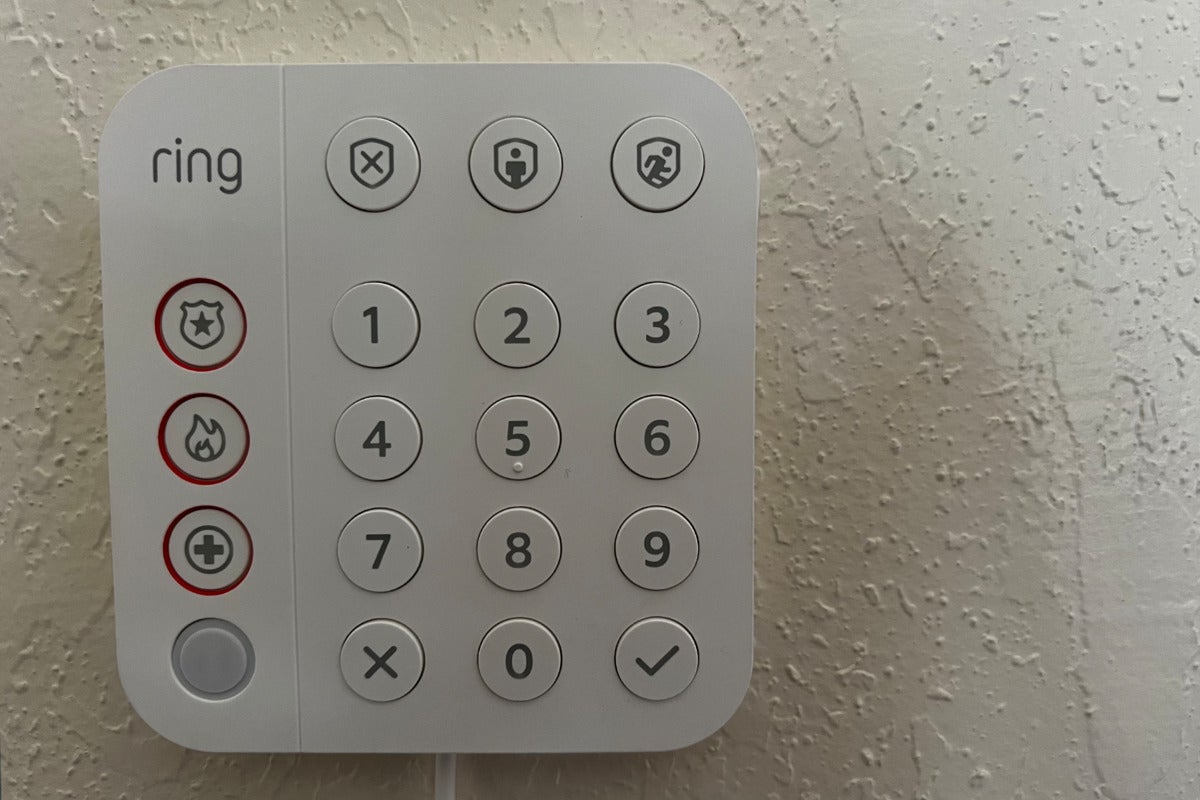 Wes Davis / IDG
Wes Davis / IDG
Ring’s keypad has large, easy-to-read buttons for arming and disarming the system and—if you’re paying for professional monitoring—for summoning help in an emergency.
The Ring Protect Pro plan
When you get down to brass tacks, Ring Protect Plans have never really been optional. For starters, Ring doorbells and cameras won’t record video without one, but Ring has always offered the industry’s least-expensive professional monitoring service. As most professional monitoring services do, Ring will try to reach you by phone if the system goes into an alarm state or if you signal an alarm yourself at the keypad. If they can’t reach you directly to verify an emergency, they’ll try your designated contacts. If they can’t reach anyone, they’ll dispatch first responders to your home in the event of a break-in, fire, or medical emergency. But Ring’s service is no longer the least expensive; in fact, the new Ring Protect Pro has doubled in price: $20 per month or $200 per year.
I happen to live in an area with a legally required an extra step—a verified response—before Ring’s professional monitoring service can dispatch help. If I can’t personally verify a true emergency—either by seeing it in person or on a live feed from one of my security cameras—I’ll need to get another eyewitness, such as a neighbor, to verify the situation. No help will be dispatched without a verified response.
If you’re under the same restriction, Ring offers Guard Response, a service that costs $75 plus $1.25 per minute after the first 20 minutes per occurrence. If the system goes into an alarm state and you can’t be reached, an unarmed guard will be dispatched to your home to verify the emergency, and that person will contact the authorities to confirm the emergency on your behalf. The best solution, obviously, is to befriend your neighbors and to purchase a security camera or two. But it’s good to know there’s a backup just in case.
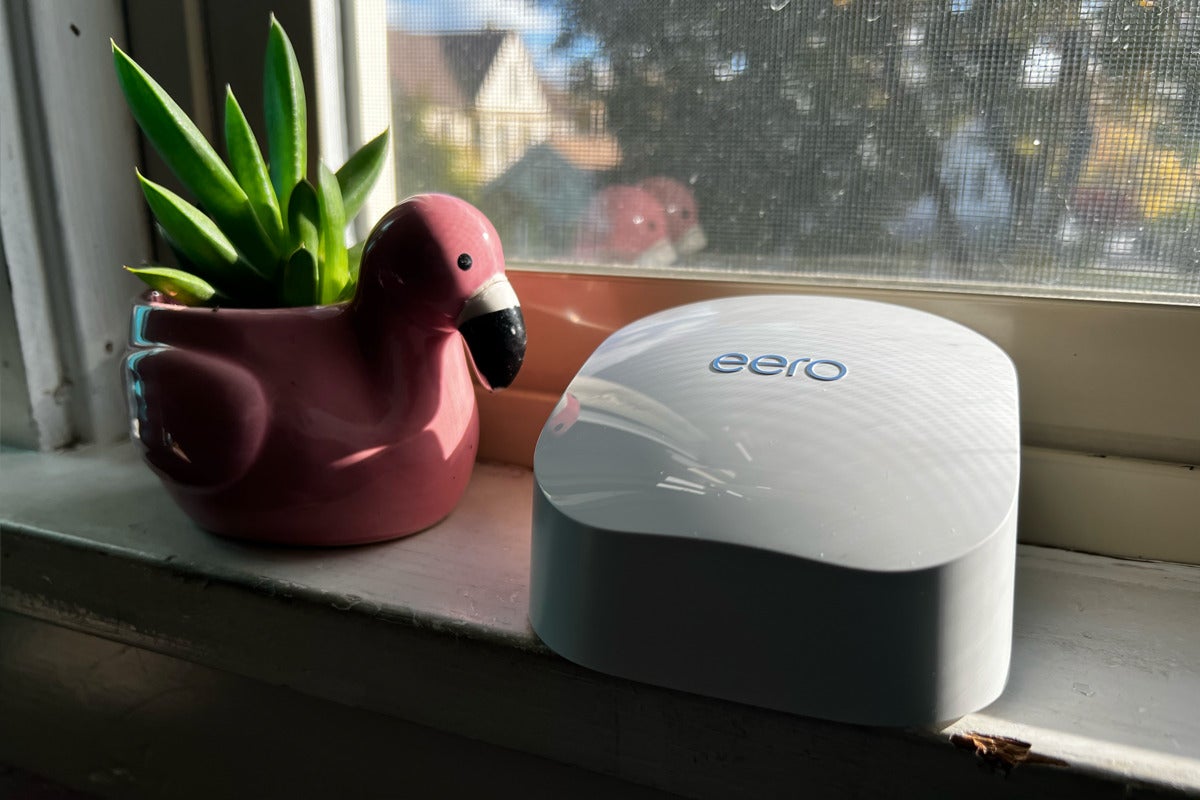 Wes Davis / IDG
Wes Davis / IDG
The range of a Ring Alarm Pro’s mesh Wi-Fi network can be extended by adding additional Eero nodes, such as the Eero 6 shown here.
Also, don’t confuse Guard Response with the new Virtual Security Guard service being offered by Rapid Response, Ring’s professional monitoring contractor. Virtual Security Guard gives agents at the company’s response center access to your security cameras. If an outdoor camera senses motion while your system is armed, an employee will check the cameras’ live feeds and engage anyone who might have triggered the sensor. They can also set off the camera’s onboard siren and/or contact the authorities. The $99-per-month service probably won’t interest the typical homeowner, but it could be a cost-effective alternative to onsite security guards for a place of business.
Bottom line
Ring Alarm and Ring Alarm Pro are our favorite DIY home security solutions, but they’re most effective when supplemented by an ostensibly optional Ring Protect plan. The integrated mesh Wi-Fi router in the newer product provides even better home security, and it costs only $50 more than the Ring Alarm (2nd Gen). Add Ring Power Packs to keep your both your broadband and security systems running during a power and/or broadband outage and you’re getting tremendous value for your dollar.
We’re much less enthused about the Ring Alarm Pro’s value as an overall smart home system. The hub’s Zigbee radio remains dormant, there’s no Thread radio onboard, and home automation routines are disjointed and clumsy, even for products certified by the Works with Ring program. If Ring could just pull that aspect together, it would have an almost unbeatable solution for smart home enthusiasts.
Updated shortly after publication to clarify that Ring provides buyers with a code redeemable for a free microSD card slot. Amazon’s webpage somewhat confusingly states that the microSD card is sold separately.



